Facilities and Instrumentation
Investigators affiliated with the Saint Louis University WATER Institute have access to state-of-the-art laboratory space that is designed to support water-related research and foster interdisciplinary collaborations.
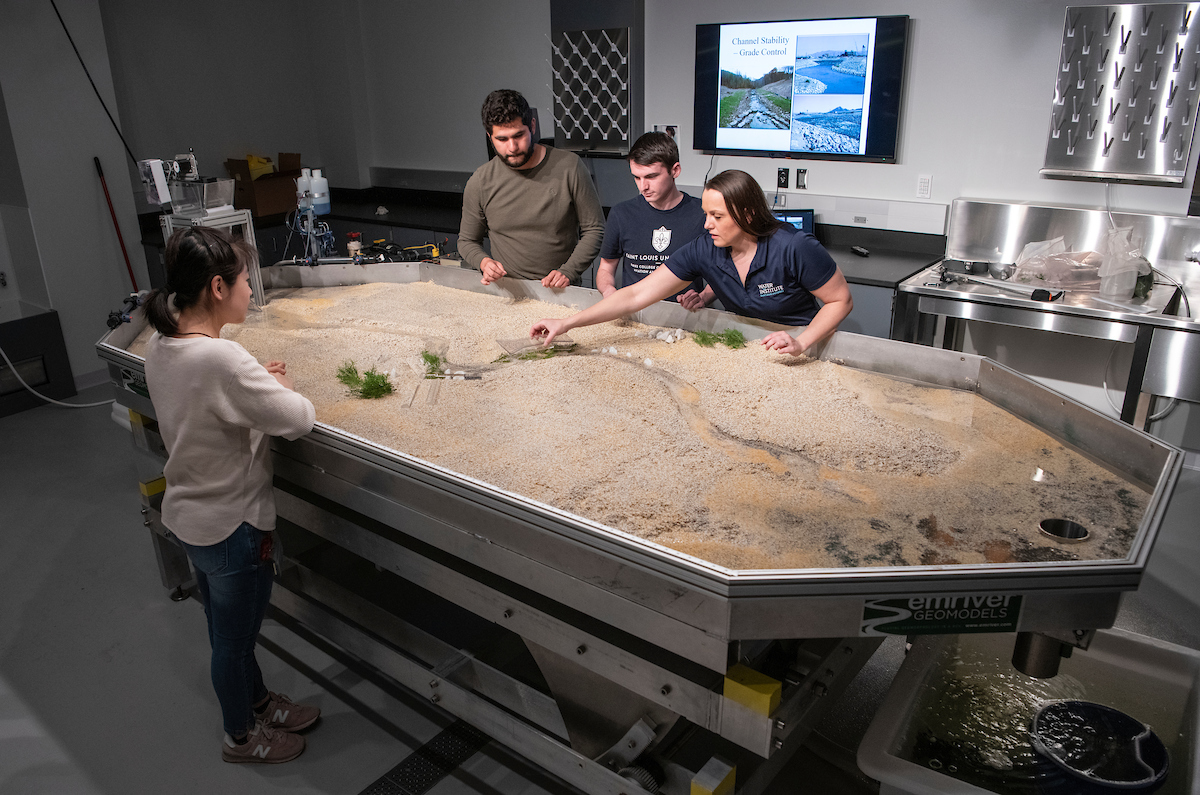
The WATER Institute research laboratories at Saint Louis University are located in the lower level of the Interdisciplinary Science and Engineering Building with a total of 3,183 square feet of space that include the Hydraulics Lab, the Wet Chemistry Lab and the Instrument Lab. The WATER Institute lab space also includes a graduate student office with 12 computer workstations and a printer, as well as a spacious field storage room that stores field and laboratory equipment for water resources research.
Explore the lab facilities and major instrumentation in the drop-down tables below. All WATER Institute facilities and equipment are supervised and maintained by engineering technician Sofie Liang, M.Sc. Please reach out to Liang with any specific facilities-related questions at water@slu.edu.
Hydraulics and Sediment Transport Analysis
The Hydraulics Lab houses an adjustable slope flume with a recirculating pump, a camera, a speaker, a large display monitor and two workstations with 64 GB RAM computers, which are equipped with software for GIS/remote sensing applications, two-dimensional hydrodynamic modeling and computation fluid dynamics. This flexible-use lab serves a dual purpose for instruction and research needs. Major equipment and field instruments are detailed below:
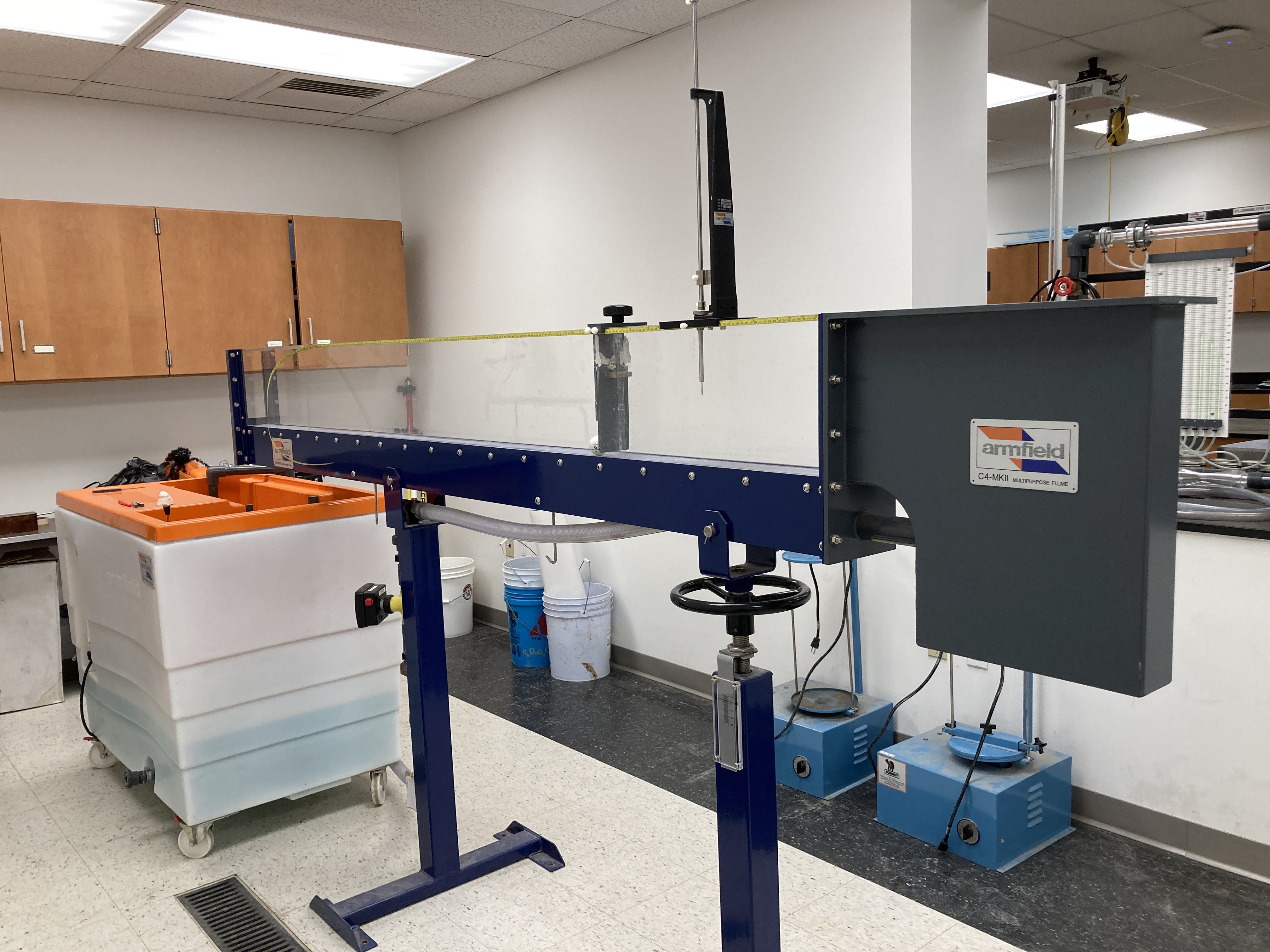 The Small Adjustable-Slope Flume is 76 mm wide, 250 mm deep and 2.5 m long with a
discharge capacity of approximately 2.0 L/s (two parallel pumps). A jacking system
allows the slope of the channel bed to be adjusted between -1% and +3%. It is instrumented
with two-point gauges accurate to +/-0.1 mm and an insertion electromagnetic flow
meter with an accuracy of 1.0%. It is also equipped with an upstream sediment injector
and a sluice gate for downstream flow control.
The Small Adjustable-Slope Flume is 76 mm wide, 250 mm deep and 2.5 m long with a
discharge capacity of approximately 2.0 L/s (two parallel pumps). A jacking system
allows the slope of the channel bed to be adjusted between -1% and +3%. It is instrumented
with two-point gauges accurate to +/-0.1 mm and an insertion electromagnetic flow
meter with an accuracy of 1.0%. It is also equipped with an upstream sediment injector
and a sluice gate for downstream flow control.
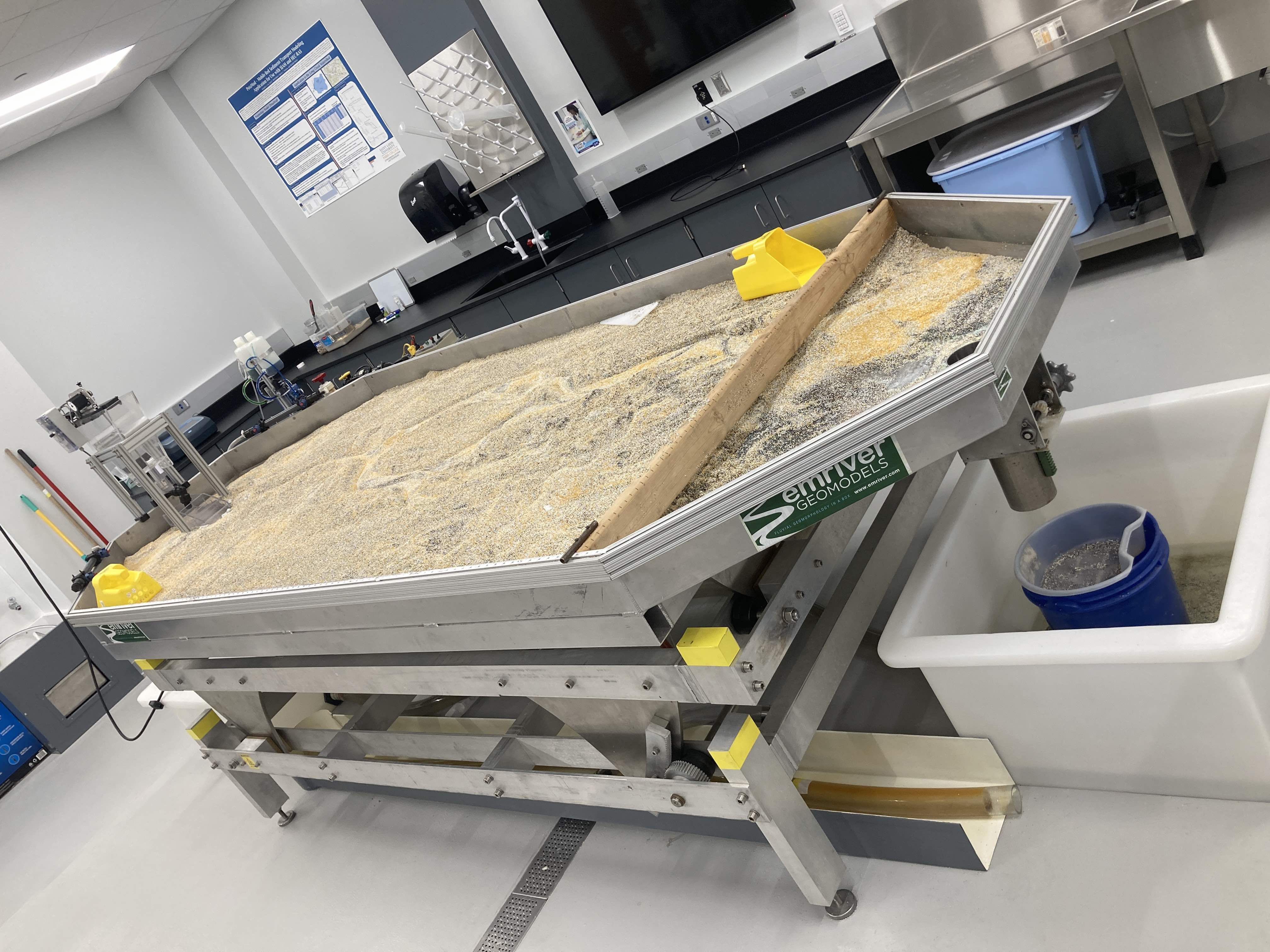 The Adjustable-Slope Flow Table, located in the Hydraulics Lab of the WATER Institute
is used for simulating open channel flow processes.
The Adjustable-Slope Flow Table, located in the Hydraulics Lab of the WATER Institute
is used for simulating open channel flow processes.
This instrument measures 3.7 m long, 1.5 m wide, 0.15 m deep and has a discharge capacity of 1.5 L/s. Both the lateral and longitudinal slope of the flume can be adjusted. The flume includes melamine plastic particles with three different sizes and colors for simulating sediment movement and a dye injection system for visualizing streamflow patterns. It is instrumented with a point gage accurate to +/-0.001 ft and an insertion electromagnetic flow meter with an accuracy of 1%.
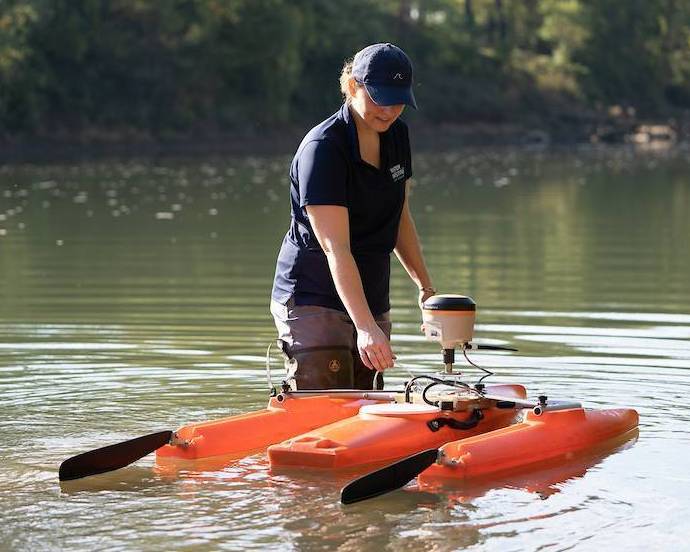 Teledyne RD RiverPro 1200 HZ Acoustic Doppler Current Profiler (ADCP) with a Hemisphere
GNSS S321 Smart Antenna Real Time Kinetic (RTK) GPS Rover. This system is for field
data collection of river velocity profiles, discharges and bathymetry.
Teledyne RD RiverPro 1200 HZ Acoustic Doppler Current Profiler (ADCP) with a Hemisphere
GNSS S321 Smart Antenna Real Time Kinetic (RTK) GPS Rover. This system is for field
data collection of river velocity profiles, discharges and bathymetry.
The WinRiver II software is installed on the field laptop to set up the system and collect data. Equipment for data collection using a tagline or kayak is also available from the WATER Institute. The inflatable kayak can be pumped manually at field sites, providing access to samples and in situ measurements in the middle of water bodies.
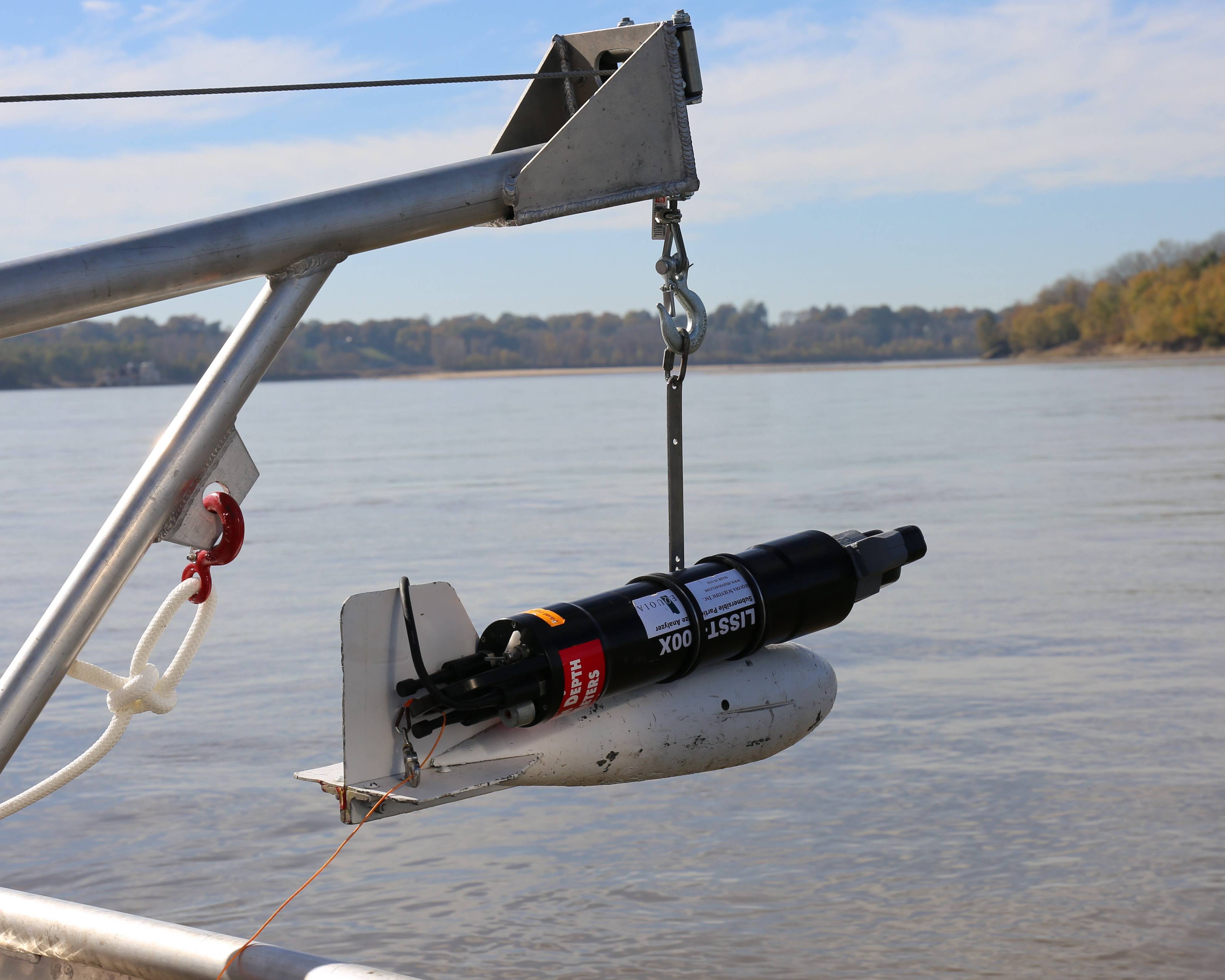 The Laser In-Situ Scattering and Transmissometry (LISST-200X) Laser-diffraction Particle
Size Analyzer collects field measurements of sediment size distributions and sediment
concentrations in river flow.
The Laser In-Situ Scattering and Transmissometry (LISST-200X) Laser-diffraction Particle
Size Analyzer collects field measurements of sediment size distributions and sediment
concentrations in river flow.
The particle-size range for the equipment is 1.00-500 μm with a 600-m depth rating. Software LISST-SOP200X is installed on the field laptop to set up the system and collect data.
The Leica ScanStation 2 LiDAR Scanner is used for measuring topography in the laboratory. The instrument has a surface precision of 2 mm.
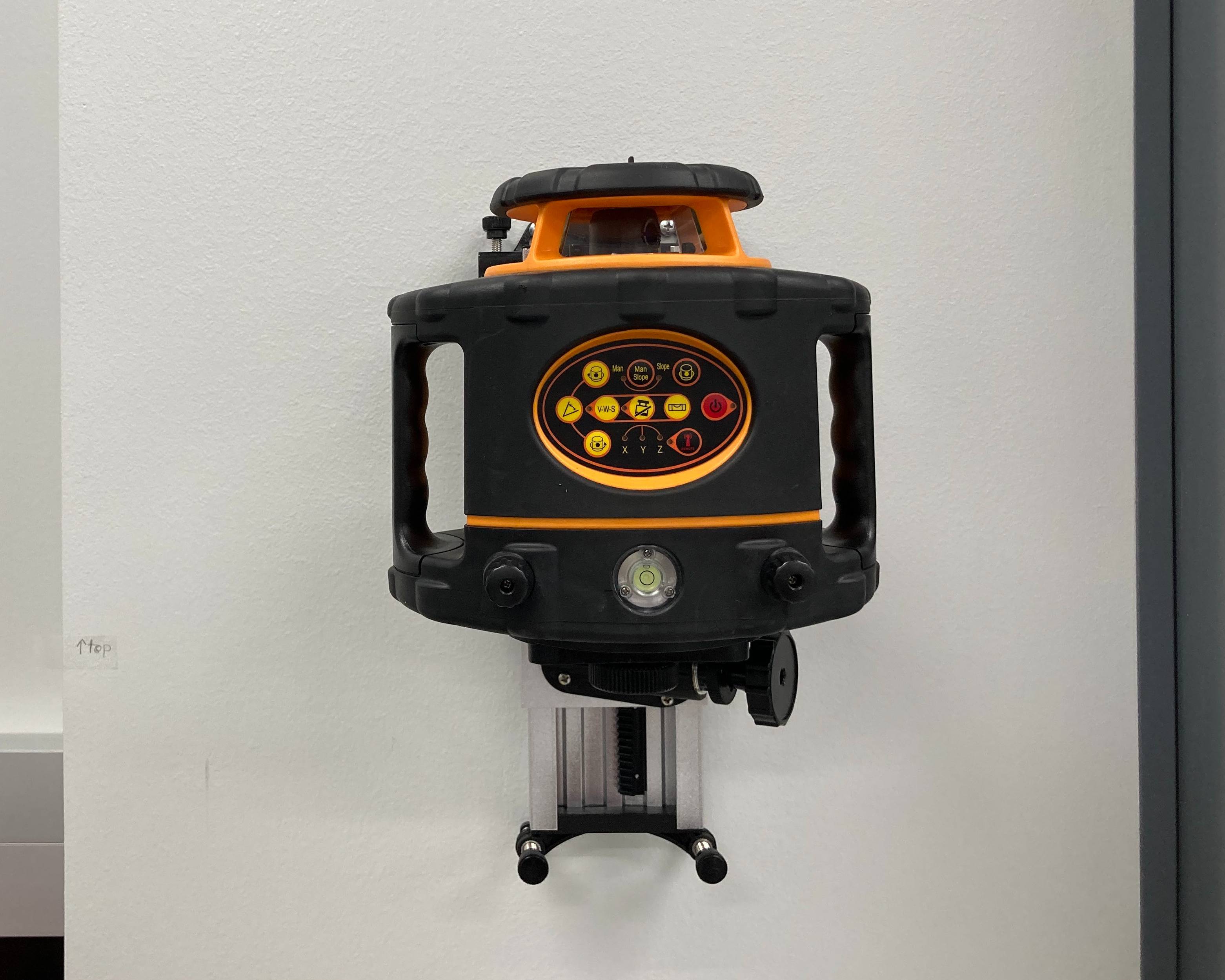 The Johnson 40-6557 Rotary Laser Level is used for measuring water-surface elevations
in the laboratory. The level has an accuracy of ±1.5 mm/30 m and an electronic self-leveling
horizontal and vertical rotary system.
The Johnson 40-6557 Rotary Laser Level is used for measuring water-surface elevations
in the laboratory. The level has an accuracy of ±1.5 mm/30 m and an electronic self-leveling
horizontal and vertical rotary system.
The Canon EOS 5D Mark III DSLR Digital Camera with an EF 24-70 mm f/4L IS USM lens can be used for recording videos of bedload sediment transport in the laboratory which is used for particle image velocimetry (PIV) processing. The camera has a 22.3 MP sensor, full HD 1080/30p and 720/60p formats and 61-point high density autofocus.
Drinking Water Quality Analysis
The Wet Chemistry Lab is equipped with three sets of benches and four fume hoods, mainly used for science and engineering experiments such as degradation and advanced oxidation of cyanotoxins, identification and control of novel taste and odor compounds in drinking water. Basic lab equipment such as a dual channel pH meter, stirrer/hot plate, high-sensitivity scale, vortex-genie mixer and single-channel and multichannel pipettes are available in this lab.
The Instrument Lab is used for running major instruments such as a quadruple time-of-flight mass spectrometer. It is also equipped with two fume hoods for sample preparation, a dust-less fume hood and a walk-in cold room (102 square feet) for sample storage.
Major equipment and field instruments are detailed below:
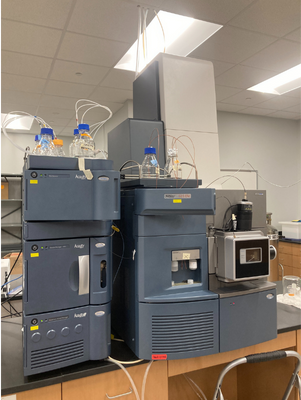 The Waters Quadrupole Time-of-flight Mass Spectrometer (QToF-MS) features ion mobility,
QuanTof, Fast DDA and MSE technologies, PDA Detector, FTN Sample Manager, Quaternary
Solvent Manager and ESI/APCI/ESCi Lockspray, which enable qualitative and quantitative
analysis of complex organic compounds such as cyanotoxins. Paired with the licensed
software Waters UNIFITM, a detection limit as low as 1 ppb can be achieved for some
compounds.
The Waters Quadrupole Time-of-flight Mass Spectrometer (QToF-MS) features ion mobility,
QuanTof, Fast DDA and MSE technologies, PDA Detector, FTN Sample Manager, Quaternary
Solvent Manager and ESI/APCI/ESCi Lockspray, which enable qualitative and quantitative
analysis of complex organic compounds such as cyanotoxins. Paired with the licensed
software Waters UNIFITM, a detection limit as low as 1 ppb can be achieved for some
compounds.
 The Shimadzu Prominence-i LC-2030 Liquid Chromatograph system includes a parallel-type
double plunger pump with purge flow rate ranging from 0.1 to 10 mL/min, gradient from
0 to 100%, in 0.1% steps, an autosampler with injection volume accuracy ±1% (50 µL,
N=10) and maximum setting range from 50 to 2000 µL, column oven temperature ranging
from 0.1 to 1.0°C, fan speed ranging from 2500 to 4500 rpm. PDA detector wavelength
ranging from 190 to 800 nm, noise level less than or equal to ±3×10-6 AU. Paired with
the software LabSolutions™ LCGC which is installed on a bench top computer.
The Shimadzu Prominence-i LC-2030 Liquid Chromatograph system includes a parallel-type
double plunger pump with purge flow rate ranging from 0.1 to 10 mL/min, gradient from
0 to 100%, in 0.1% steps, an autosampler with injection volume accuracy ±1% (50 µL,
N=10) and maximum setting range from 50 to 2000 µL, column oven temperature ranging
from 0.1 to 1.0°C, fan speed ranging from 2500 to 4500 rpm. PDA detector wavelength
ranging from 190 to 800 nm, noise level less than or equal to ±3×10-6 AU. Paired with
the software LabSolutions™ LCGC which is installed on a bench top computer.
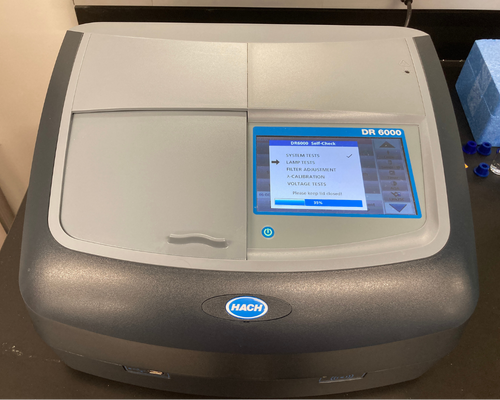 The DR6000 UV-VIS split beam Laboratory Spectrophotometer scans across the UV and
visible spectra (wavelengths ranging from 190 nm to 1100 nm), and comes with over
250 pre-programmed methods, which provide qualitative and quantitative analyses for
a wide-range of water testing efforts such as chemical oxygen demand, chlorine, nitrate
and ammonia. With optional accessories allowing for high volume testing via a carousel
sample changer and increased accuracy with a sample delivery system which eliminates
optical difference errors. This spectrophotometer is paired with drinking water analysis
application software.
The DR6000 UV-VIS split beam Laboratory Spectrophotometer scans across the UV and
visible spectra (wavelengths ranging from 190 nm to 1100 nm), and comes with over
250 pre-programmed methods, which provide qualitative and quantitative analyses for
a wide-range of water testing efforts such as chemical oxygen demand, chlorine, nitrate
and ammonia. With optional accessories allowing for high volume testing via a carousel
sample changer and increased accuracy with a sample delivery system which eliminates
optical difference errors. This spectrophotometer is paired with drinking water analysis
application software.
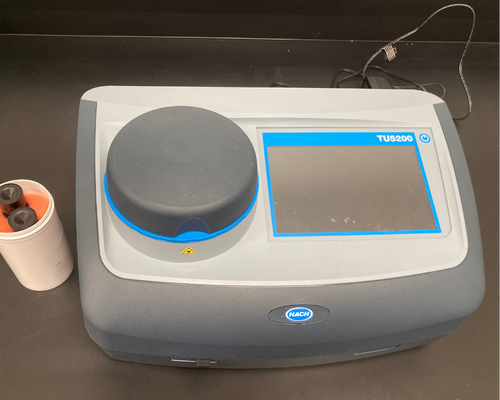 The Laboratory Laser Turbidimeter (EPA Version) employs a patented optical design
that delivers low level precision and sensitivity while maximizing consistency from
test to test. Range minimum is 0 NTU. The accuracy is ± 2% of reading plus stray light,
which is less than or equal to 0.02 NTU.
The Laboratory Laser Turbidimeter (EPA Version) employs a patented optical design
that delivers low level precision and sensitivity while maximizing consistency from
test to test. Range minimum is 0 NTU. The accuracy is ± 2% of reading plus stray light,
which is less than or equal to 0.02 NTU.
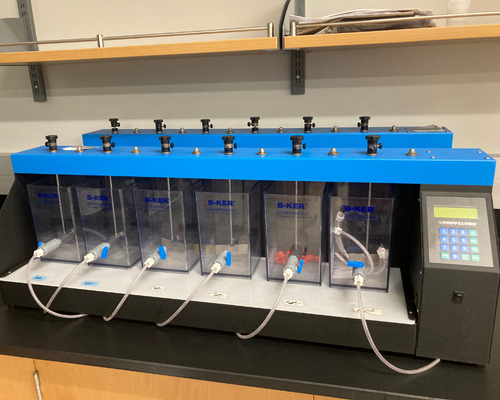 The Six-Paddle Stirrer is used to determine the exact amount of alum or polymer necessary
to trigger flocculation. The stirrer design is based on method D 2035 (Standard Practice
for Coagulation - Flocculation Jar Test of Water) in the ASTM Standards: Section 11,
Water and Environmental Technology (volume 11.02). The stirrer includes six square
2-L B-Ker2® beakers that stir up to six samples simultaneously with a stirrer speed
ranges from 0 to 300 rpm. A built-in LED floc illuminator provides diffused lighting
of samples.
The Six-Paddle Stirrer is used to determine the exact amount of alum or polymer necessary
to trigger flocculation. The stirrer design is based on method D 2035 (Standard Practice
for Coagulation - Flocculation Jar Test of Water) in the ASTM Standards: Section 11,
Water and Environmental Technology (volume 11.02). The stirrer includes six square
2-L B-Ker2® beakers that stir up to six samples simultaneously with a stirrer speed
ranges from 0 to 300 rpm. A built-in LED floc illuminator provides diffused lighting
of samples.
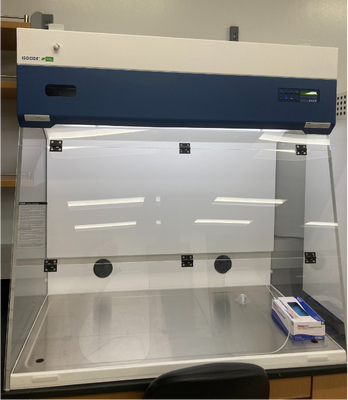 The Dustless Fume Hood is a self-contained, filtered laboratory enclosure that removes
hazardous fumes, vapors and particles from the laboratory, thus providing dustless
operational environment for biological experiments. It also protects the operators
from touching or inhaling harmful chemicals.
The Dustless Fume Hood is a self-contained, filtered laboratory enclosure that removes
hazardous fumes, vapors and particles from the laboratory, thus providing dustless
operational environment for biological experiments. It also protects the operators
from touching or inhaling harmful chemicals.
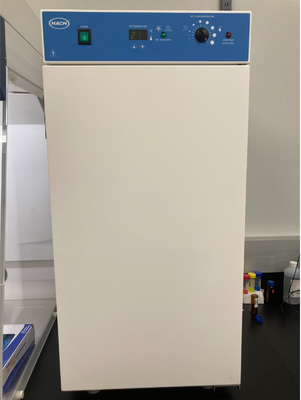 The Hach Model HRI3P Low Temperature Biochemical Oxygen Demand (BOD) Incubator is
used analyzing sewage and wastewater as well as other low temperature applications.
It is thermoelectric cooled, eliminating the need for a refrigeration compressor.
The incubator includes a mechanical convection system, digital temperature set controller,
over temperature limit control and a temperature display. The instrument includes
35-lb capacity shelves and two one-amp-interior outlets which allow the use of shakers,
stirrers, roller bottles or two BOD Trak apparatus.
The Hach Model HRI3P Low Temperature Biochemical Oxygen Demand (BOD) Incubator is
used analyzing sewage and wastewater as well as other low temperature applications.
It is thermoelectric cooled, eliminating the need for a refrigeration compressor.
The incubator includes a mechanical convection system, digital temperature set controller,
over temperature limit control and a temperature display. The instrument includes
35-lb capacity shelves and two one-amp-interior outlets which allow the use of shakers,
stirrers, roller bottles or two BOD Trak apparatus.
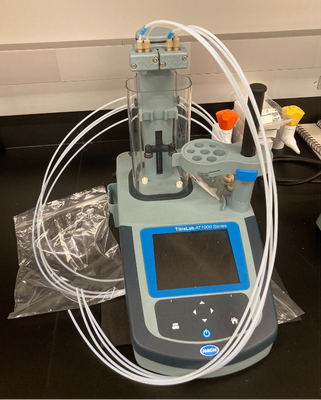 The Hach Automatic Titrator includes two burettes, two pumps and two measurement inputs,
which improves accuracy and reliability of the measurements and enhances lab throughput.
It can be paired with any of the Hach Application Packs, including pH, Alkalinity
and Hardness in water; pH, Total Acidity and Chlorides in Food and Beverage; and pH,
Total Acidity and Free and Total SO₂ in Wine. Each application pack includes a pre-programmed
application that runs on the instrument as well as a set of accessories necessary
to perform the titrations.
The Hach Automatic Titrator includes two burettes, two pumps and two measurement inputs,
which improves accuracy and reliability of the measurements and enhances lab throughput.
It can be paired with any of the Hach Application Packs, including pH, Alkalinity
and Hardness in water; pH, Total Acidity and Chlorides in Food and Beverage; and pH,
Total Acidity and Free and Total SO₂ in Wine. Each application pack includes a pre-programmed
application that runs on the instrument as well as a set of accessories necessary
to perform the titrations.
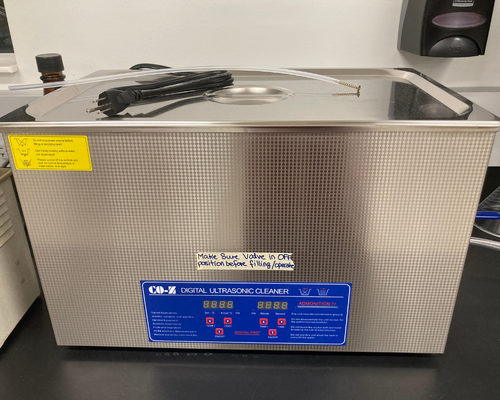 The Digital ultrasonic cleaner is built with ultrasonic transducers with 600 W total
power combined with 800 W of heating power to easily sanitize lab materials. The device
contains a stainless-steel tank with 30-L capacity and dimensions of 20" × 12" × 8".
The temperature settings range 40-60℃.
The Digital ultrasonic cleaner is built with ultrasonic transducers with 600 W total
power combined with 800 W of heating power to easily sanitize lab materials. The device
contains a stainless-steel tank with 30-L capacity and dimensions of 20" × 12" × 8".
The temperature settings range 40-60℃.
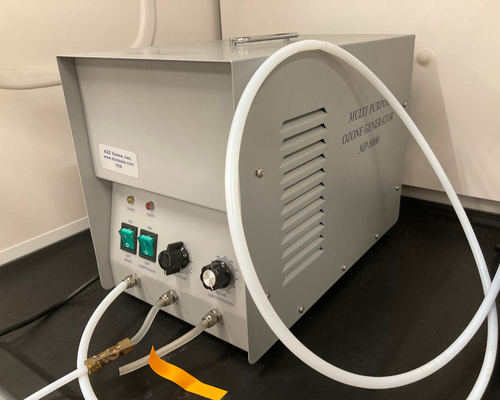 The A2Z Multipurpose MP-8000 Ozone Generator is equipped with an optional oxygen feed
hook up. It has the option to set up the timer (15-min to 4-hour range) for duration
of the ozone generation. The maximum ozone output is 8 g/hour, with concentration
range 0-45 g/m3.
The A2Z Multipurpose MP-8000 Ozone Generator is equipped with an optional oxygen feed
hook up. It has the option to set up the timer (15-min to 4-hour range) for duration
of the ozone generation. The maximum ozone output is 8 g/hour, with concentration
range 0-45 g/m3.
Environmental Science and Geochemistry Analysis
The Environmental Geochemistry Laboratory consists of 1700 square feet of wet chemical laboratory space that houses standard equipment needed for water quality measurements, soil and rock chemistry characterization and stable isotope analysis. It is equipped with three fume hoods, vacuum, gas and air hookups.
The laboratory contains all the equipment needed for analyzing water, soil and rock samples, including pH meters, wet chemistry glassware and reagents, vacuum water filtration systems, magnetic stir/hot plates, microscopes, centrifuges, temperature control baths, drying ovens and a shaker.
Major equipment and field instruments are detailed below:
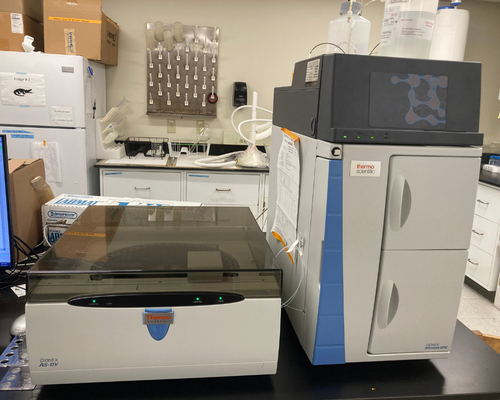 The Thermo Scientific Dionex Integrion High Performance Ion Chromatograph is an analytical
technique used for water chemistry analysis.
The Thermo Scientific Dionex Integrion High Performance Ion Chromatograph is an analytical
technique used for water chemistry analysis.
It is equipped with Dionex AG18 Guard (4×50 mm) Column, AS18 Analytical (4×250 mm) Column, EGC-KOH II Cartridge and Anion Self-Regenerating Suppressor. The instrument can measure concentrations of major anions, such as fluoride, chloride, nitrate, nitrite and sulfate in the parts-per-billion (ppb) range. Software Chromeleon (7.2.10) is installed on the bench top computer to operate the instrument and collect data.
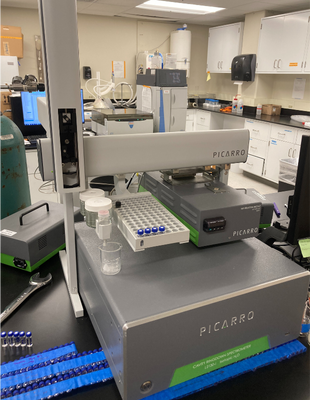 The Picarro L2130-i Cavity Ringdown Spectrometer Isotopic Water Analyzer is used to
measure water stable isotopes for applications such as hydrology, oceanography and
paleoclimatology.
The Picarro L2130-i Cavity Ringdown Spectrometer Isotopic Water Analyzer is used to
measure water stable isotopes for applications such as hydrology, oceanography and
paleoclimatology.
δ18O and δ2H high-precision measurements can be made with water samples from liquids, vapor and solids using a variety of Picarro peripherals including an autosampler with the SGE syringes and a high-precision vaporization module. The throughput for standard mode is 6 injections 54 minutes per sample, and for express mode, 10 injections 29 minutes per sample. Precision with a liquid sample is 0.025/0.1‰ for δ18O/δD, and drift, over 24 hours, is 0.2/0.8‰ for δ18O/δD. Vapor specifications include a measurement range from 1,000 to 50,000 ppm, with precision at 2,500 ppm of 0.250/0.080‰ and 1.600/0.500‰, and at 12,500 ppm of 0.120/0.040‰ and 0.300/0.100‰ for δ18O (for 10/100 sec) and δ2H (for 10/100 sec), respectively. Software Picarro CRDS (g2000_win7-1.5.0-26) is installed on the bench top computer to operate the instrument and collect data.
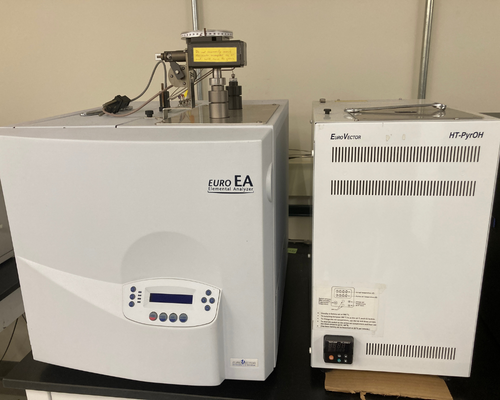 The EuroEA High Temperature Pyrolysis Elemental Analyzer Unit transforms solid and
liquid samples into simple gases such as CO2, N2, CO, SO2 and H2, which can be admitted
into the IsoPrime mass spectrometer.
The EuroEA High Temperature Pyrolysis Elemental Analyzer Unit transforms solid and
liquid samples into simple gases such as CO2, N2, CO, SO2 and H2, which can be admitted
into the IsoPrime mass spectrometer.
It includes a combustion reactor that is held at 1020-1100°C depending on the elemental species of interest. A reduction reactor containing copper granules is maintained at 650°C, then a Mg (ClO4)2 filter is used to remove water. The instrument includes a short chromatographic column and a thermal conductivity detector for basic qualitative and quantitative analysis. Two configurations are possible: 1) NC configuration, used for the analysis of N alone, C alone and sequential NC, or 2) S configuration, used for the analysis of S alone. Software MassLynx (Sept 25, 2003) is installed on the bench top computer to operate the instrument and collect data. It has passed the preliminary leak test and temperature test but failed the valve test.
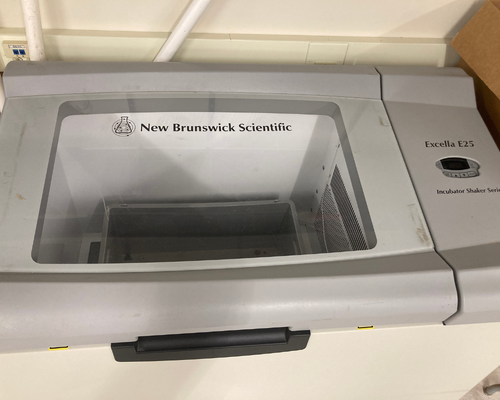 The New Brunswick Scientific Excella E25 Incubator Shaker features heavy-duty counterbalanced
drive, viewing window and internal light with the ability to shake while maintaining
optimal conditions (temperature, speed and running time) for incubating various microbes
or DNA replications for biological experiments.
The New Brunswick Scientific Excella E25 Incubator Shaker features heavy-duty counterbalanced
drive, viewing window and internal light with the ability to shake while maintaining
optimal conditions (temperature, speed and running time) for incubating various microbes
or DNA replications for biological experiments.
It utilizes a UniCentric single eccentric counterbalanced drive to provide horizontal plane rotary motion in a 2.54 cm circular orbit. The proportional/integral (PI) microprocessor controller with instantaneous digital feedback controls the speed over a range of 50-400 rpm. The E-25R provides temperature control over a range of 15℃ below ambient temperature (minimum 4℃) to 60℃. The shaker also features a timed mode via a programmable timer for shaking periods of 0.1-99.9 h.
The YSI EXO2 and 6-Series Multiparameter Water Quality Sondes are long-term deployment instruments that collect water quality data in situ continuously.
The sonde collects data with up to seven user-replaceable sensors and an integral pressure transducer. Each sensor measures a specific parameter such as temperature, conductivity, pH, turbidity, dissolved O2 and Cl- via a variety of electrochemical, optical or physical detection methods. Depending on user-defined settings, the sonde will collect data and store it, transfer the data to a data collection platform, or relay it to a user’s PC or handheld device via Bluetooth connection. The KorEXO Software is installed on the field laptop to conduct calibration and data exportation.
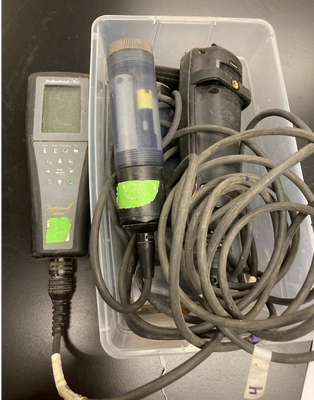 The YSI Professional Series Handheld Multiparameter Meters measure water quality data
on site. It collects data with up to four user-replaceable sensors; each measures
a specific parameter including temperature/conductivity, pH, dissolved O2 and Cl-.
The YSI Professional Series Handheld Multiparameter Meters measure water quality data
on site. It collects data with up to four user-replaceable sensors; each measures
a specific parameter including temperature/conductivity, pH, dissolved O2 and Cl-.
In addition to the major equipment detailed above, the laboratory maintains an extensive array of instruments, including:
- Millipore Milli-Q Water Purification System
- Mettler Toledo Analytical Balances
In addition to the instruments detailed above, the laboratory maintains an extensive array of field equipment including:
- YSI Professional Series Handheld Multiparameter Meters
- AquaFluor Handheld Fluorometer
- Hach 2100Q Portable Turbidimeter
- Solinst water level loggers
- ISCO 3700 and 6712 automated water samplers
Geotechnical Analysis
The Geotechnical Laboratory is equipped with the traditional equipment for soil mechanics. It includes load frames, ovens, furnace, sieve stacks, mechanical shakers and mixers. More specifically, the following geotechnical engineering tests can be completed: water content, Atterberg limits, particle size analysis, permeability, specific gravity, compaction, consolidation, unconfined compression test and triaxial testing.
Computer and Computational Resources
The WATER Institute has computer workstations for data analysis equipped with LabVIEW software and data processing and analysis using MATLAB and ArcGIS. Saint Louis University has a high-performance computing cluster with 800 processors.